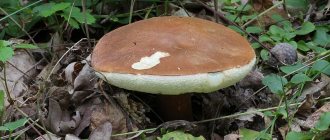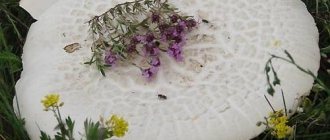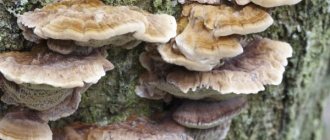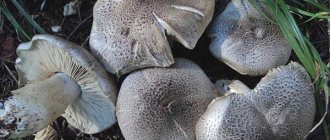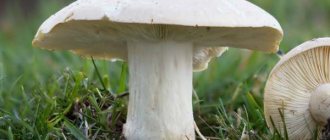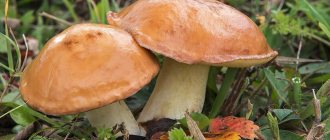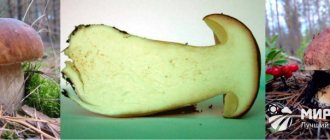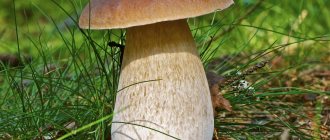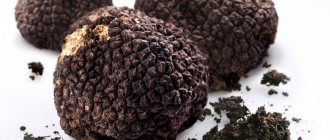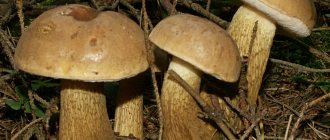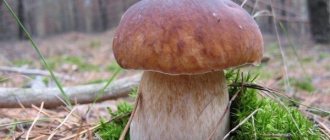This representative of the mushroom kingdom of nature is considered one of the most delicious, tender and appetizing. However, it has several analogues that are poisonous to the human body. In this article we will take a closer look at the porcini mushroom, including its main characteristics. Enjoy reading!
What does a porcini mushroom look like?
What is it also called
In fact, the white mushroom is so popular that in different regions and people's circles it can have completely different names. So, the most common are:
- capercaillie;
- cowshed;
- bear bear;
- barn;
- belevik;
- feather grass;
- yellowtail;
and so on.
This mushroom is called porcini for the simple reason that in any condition: fresh, boiled, fried, frozen - it remains white. This is not typical for other mushrooms, but for white mushrooms it is an absolute indicator of the norm.
Where to collect
The porcini mushroom settles depending on growing conditions, climate and weather conditions, but does not like extremes. It can usually be found in fairly dry forests located on a slightly elevated area. Although it chooses rather bright and illuminated places, it hides among short grass, under leaves, forest litter, among mosses and lichens and under sparse tree branches.
Information! The most favorable conditions for the massive growth of porcini mushroom are short-term thunderstorms and warm nights with fog.
On waterlogged, swampy soils, it tries to climb higher, where it is drier. When the temperature drops, the porcini mushroom grows more often in open, well-warmed places by the sun. In hot and dry summers, the mushroom “goes” deeper into the forest, where it is cooler and there is more moisture. It may also descend to a wetter lowland.
At the same time, in the summer, porcini mushrooms are found alone, and in the fall they form small families.
Information! Significant differences in day and night temperatures and large amounts of precipitation prevent the appearance and growth of white fungus.
There are also certain signs that most likely indicate the habitats of porcini mushrooms nearby. These are anthills with red ants, from plants - sedge, whitebeard, wintergreen, broom, heather, pylon, blueberry; from mushrooms - fly agaric, valui, chanterelles, greenfinches, green russula.
How to distinguish a real porcini mushroom
If you went into the forest to pick a porcini mushroom, then you need to know its main external signs. Otherwise, you risk picking completely different mushrooms, and it’s okay if they are edible, but you can get poisoned. Therefore, it is recommended that beginners in mushroom picking invite experienced mushroom pickers with them on their hikes. They will not only prevent you from making mistakes and teach you how to identify edible and inedible mushrooms, but will also tell you a lot of interesting things. Now let's look at what a porcini mushroom looks like.
How to distinguish a real porcini mushroom
Appearance
Any boletus (another name for porcini mushroom) should have a characteristic mushroom smell. It is still very similar to anise. However, in forest conditions, this smell can only be smelled if you stumble upon a large clearing of porcini mushrooms or bring it close to your nose. In addition, all types of porcini mushroom have similar features, which we will discuss in the article below. You are unlikely to be able to remember them right away, so it is recommended to save a photo of the boletus.
Description
So, in the appearance of a boletus there are three main elements: the cap, the stem and the pulp. Of course, mycorrhiza is no less important, but the mushroom picker, as a rule, does not see it. Therefore, there is no point in talking about it here. Now let's take a closer look at what a porcini mushroom looks like in the forest.
hat
The color of the boletus cap is brownish-brownish, and the diameter can reach 30 centimeters. In some regions, the cap of a porcini mushroom can be even half a meter in diameter, but this is more the exception than the rule. In rain, the cap becomes covered with mucus, but in drought it begins to crack a little. A characteristic feature is the tight adhesion of the cap to the stem.
Boletus cap color
Leg
From the cap it smoothly passes to the stem of the porcini mushroom. In this representative of the mushroom kingdom, it is thick and massive; it can reach 20 centimeters in height and 6 centimeters in thickness. It comes in two forms: cylindrical and club-shaped - as a rule, it begins to expand towards the base. Its color is white, sometimes light brown. At the same time, the leg is perfectly clean, that is, there are no skirts or other elements on it - this is a characteristic feature of the porcini mushroom.
Pulp
Adult boletus mushrooms have unusually dense flesh similar to mushrooms. In addition, it is juicy, fleshy and characterized by a white color. If the mushroom is already overripe, the pulp becomes fibrous. At the same time, the color changes - it becomes yellowish or beige. Such mushrooms can also be collected, they are edible. But still, ripe mushrooms are much tastier, more appetizing and healthier.
Types of porcini mushrooms: photos and names
Birch (kolossovik) - has a beige cap, grows in birch forests. Often found in forests in Russia.
Mesh - has a brown or orange cap and a short cylindrical stem. Grows in beech, oak, hornbeam forests of Europe and northern Africa.
Bronze - has a dark brown cap and the same dark leg, but at the same time white flesh. Grows in deciduous forests of North America, southern and western Europe.
Birch (kolossovik)
Pine - has a cap of a dark, often purple, color. The color of the flesh of this boletus is brown-red. Found in pine forests of northern Europe.
Oak - has a gray-brown cap with light spots. Grows everywhere in oak forests.
Spruce - has a long club-shaped stem and a chestnut-colored cap. Grows in spruce and fir forests. The duration of the growing season of boletus depends on latitude: in northern latitudes - from June to September, in temperate latitudes - from May to November. Most often they grow in families, and reach maturity a week after emergence, which is a long cycle for mushrooms.
Season and places of growth
Boletuses grow all over the world: in mixed forests of North and South America, Eurasia, and Africa. They are often found at the base of oaks, birches, beeches, hornbeams, spruces, pines, fir trees; they prefer mosses and lichens. The soil can be any kind, but not swamps and peat bogs. They love sunny places and grow in partial shade; their growth stops when the air temperature becomes low.
Find out also how boletus mushrooms grow in the forest.
The names of some species indicate their place of growth:
- birch trees in birch groves, as well as on sunny edges throughout the country. Experienced mushroom pickers begin their “hunt” in July and easily find a meadow with birch trees. The collection continues until the first frost.
- Pine trees must be looked for in forests. They form mycorrhiza (mycelium of the fungus colonizes the roots of the tree) with oaks, spruces, and chestnuts. The collection takes place from mid-July to the end of September.
- Oak trees are common in oak forests of the Primorsky Territory, in central Russia and in the south. They grow in moderately moist neutral soils. Activation of growth is observed throughout the summer period, ending in October.
- Spruce trees grow in spruce forests from June to autumn. Their growth begins after rainy weather with dense fogs. In forests with free access to the sun's rays, they are found in lowlands, and in dark forests they are found on dry islands. The collection lasts from September to October.
The growth cycle of mushrooms is influenced by climate and location of growth, so it is characterized by instability. In warm areas, boletus mushrooms grow in June – November. In the northern regions of the country in June they are found in places, and mass collection begins only in August; by the end of September their growth stops due to cold weather. Porcini mushrooms grow in colonies. The amount of useful substances is actively reduced after cutting, so they are processed immediately.
Did you know? According to Turkish custom
-
once a year, residents collect porcini mushrooms, and then have a feast, sing songs, and dance.
Growing boletus mushrooms is very difficult; you need patience and good conditions. The porcini mushroom forms colonies on the roots of trees - this form of cohabitation is called symbiosis. Therefore, it is necessary to begin cultivation by planting spruce, pine, and birch trees.
Next, having chosen one of the presented methods, we begin to plant the forest gifts of nature:
- Boletus mushrooms must be crushed, left in water for more than a day, mixed, and strained. The infusion contains spores of porcini mushrooms. The liquid must be evenly distributed under the plants.
- In the forest they look for the place where the mycelium is located, they dig it up and bring it to the site. Small depressions are dug under the birch trees, the bottom of which is covered with mycelium, then sprinkled with soil from the forest. The mycelium is watered moderately.
- Mature boletus caps are cut into small pieces and mixed with moist soil, then they should be laid out under the trees.
Regular watering allows you to collect the first boletus mushrooms in 12 months, and in subsequent years - entire colonies.
How to prepare and store
After harvesting, porcini mushrooms can be stored in the refrigerator for no more than a day. Because they need to be prepared immediately, otherwise they will spoil. In general, boletus mushrooms can be prepared in any way convenient for you: boiled and frozen, pickled, pickled, fried, dried or canned. Depending on the chosen method, the method and shelf life of the mushrooms will differ.
Useful and medicinal properties of porcini mushroom
Useful and healing properties
Porcini mushrooms are valued for their high taste. They contain few substances essential for the human body, so they cannot be classified as products that must be present in any diet. However, for vegetarians who do not consume animal protein, dried boletus can be a good alternative.
Porcini mushrooms contain:
- vitamins (, , , , group B);
- minerals (potassium, sodium, calcium, phosphorus, magnesium, iron, manganese, cobalt, fluorine, selenium, zinc, iodine, sulfur);
- alimentary fiber;
- polysaccharides (chitin, glycogen, beta-glucan);
- alkaloids (hertzedine and skull);
- proteins and amino acids, including ergothioneine;
- fats, including lecithin;
- enzymes.
Porcini mushrooms have a number of useful and medicinal properties, which include:
- dietary value - low energy value (100 g of fresh porcini mushrooms contains 34 kcal);
- the ability to stimulate the secretion of digestive glands;
- tonic properties;
- immunomodulatory effect;
- antimicrobial effect;
- hypocholesterolemic properties (thanks to lecithin);
- regenerating properties (due to ergothioneine);
- antioxidant effect (due to beta-glucan);
- wound healing effect (externally).
In medicine, porcini mushrooms are rarely used as a medicine. The main indications for their treatment are:
- prevention of cancer. According to statistics, women who regularly eat boletus are less likely to suffer from breast cancer. This fact suggests that they have anti-cancer properties, probably due to their high content of sulfur associated with polysaccharides;
- diet therapy for tuberculosis. The immunomodulatory, antimicrobial and tonic properties of boletus mushrooms strengthen the weakened immune system of patients;
- atherosclerosis. Lecithin contained in boletus mushrooms reduces cholesterol levels in the blood;
- frostbite. An aqueous extract from dried boletus mushrooms, when applied externally, helps restore skin after frostbite.
Before using boletus mushrooms for medicinal purposes, you must visit a qualified doctor. Mushrooms cannot replace the basic therapy of diseases: they can only be an auxiliary agent in their complex treatment.
Where do porcini mushrooms grow?
In fact, porcini mushrooms are considered one of the most common and numerous among all representatives of the mushroom kingdom of nature. So, they can be found on all continents, except perhaps icy Antarctica and Australia, which is an arid country. As a rule, porcini mushrooms live in mixed (coniferous-deciduous) forests and prefer to grow under trees that are more than 50 years old.
Where do porcini mushrooms grow?
Hazardous properties
Fresh boletus mushrooms contain a difficult-to-digest substance - chitin, so they are considered heavy food, the digestion of which requires increased work of all digestive glands. There is no chitin in dried porcini mushrooms, so the protein benefits of products prepared in this way are much higher than when consumed fresh or thermally processed.
The difficulty of digesting boletus mushrooms is a reason to limit their consumption or refuse to take them. Contraindications to their use are:
- children (up to 12 years) and old age;
- pregnancy and breastfeeding;
- diseases of the digestive tract (gastritis, colitis, pancreatitis, cholelithiasis, digestive disorders);
- individual intolerance;
- allergic reactions.
Fresh young white forest products do not contain harmful substances. Toxic substances can accumulate in the pulp of mushrooms if they:
- overripe;
- affected by diseases, worms and other pests;
- poorly cleaned;
- grow in industrial areas, near busy highways, landfills, sedimentation tanks, agricultural lands or livestock enterprises;
- not harvested within 8-10 hours after collection;
- preserved without following sterilization regimes.
Possible side effects when consuming such porcini mushrooms:
- digestive disorders (nausea, vomiting, diarrhea);
- increased body temperature;
- stomach ache;
- weakening of the pulse;
- coldness of fingers and toes;
- neurological disorders (confusion, impaired sensitivity or motor activity).
If the sterilization regime is not followed when canning poorly peeled boletus mushrooms, botulinum toxin may accumulate in the product, which causes paralysis of the respiratory muscles, which can be fatal.
Growing porcini mushrooms at home
If you don’t want to constantly go into the forest to pick mushrooms, but want to eat porcini mushrooms at home all the time, then growing porcini mushrooms at home may be the optimal solution. However, it is worth noting right away: this will not be so easy. It is necessary to constantly care for them, maintain a certain temperature and humidity, and also buy soil, mycelium and other components. By the way, this is a great idea for a business, since the grown porcini mushrooms can then be sold. Watch the video to learn how to grow porcini mushrooms at home.
Culinary and medicinal applications
Boletus is eaten fresh, boiled, fried, salted, or pickled. A variety of culinary dishes are prepared from it. The dry powder is used as a seasoning to add to a variety of dishes. Italians eat raw mushrooms in salads. Boletus sauces are in harmony with rice and meat, and dressings are added to first courses.
Mushroom pickers, after bringing boletus mushrooms into the house, try to process the harvest in a short time. For this purpose, the mushrooms are soaked in cool water for at least an hour, this makes the needles and leaves easier to separate. Next, they clean it, cutting off the damaged areas, cut it into pieces, checking the internal cleanliness.
Dried mushrooms:
- in the oven at + 50°C, placing their parts on parchment paper for at least 8 hours, with the door slightly opened so that the mushrooms do not release juice when heated;
- The microwave oven is turned on at 180 W for 15 minutes, repeating this process three times, ventilating the product between dryings.
When properly stored, they retain their beneficial properties for a long time.
Boletus is known for its generous composition of vitamins, which is why it is actively used in medicine. It contains vitamins A, B1, B2, B5, B6, B9, C, D, E and PP, so it is used for vitamin deficiency, to normalize the activity of the thyroid gland, to treat inflammation and infections.
Important! Before freezing several containers of boletus mushrooms, it is recommended to first boil them in salted water for 5 minutes.
In medicine, it is successfully used in the prevention of tuberculosis, to activate the body's metabolism, and to treat ulcers. Boletus pulp contains calcium and iron, which are necessary for the formation of bone and connective tissue. Flour made from real porcini mushroom is used to prevent osteoporosis, treat anemia and strengthen the heart.
By consuming a food supplement based on boletus, the human body increases hemoglobin and improves immune defense. Lecithin, which is part of boletus, helps prevent the formation of cholesterol plaques in blood vessels.
The peculiarity of the “favorite” of mushroom pickers is the renewal of human body cells due to the presence of an amino acid called ergothioneine. Boletus mushrooms are rich in unsaturated fatty acids, which prevent the development of atherosclerosis. They also contain a lot of fiber, which promotes the digestion process.
Varieties
In the article above, we have already briefly reviewed the main varieties of porcini mushroom. Here I propose to study them in more detail and in detail, so that you do not think that these are poisonous analogues. But since there are many varieties, let’s take the 3 most popular types for central Russia.
Pine
Pine
is considered extremely common. The cap can reach a size of 0.2 m, but the bottom of the pine porcini mushroom, with a height of fifteen centimeters, has only a five-centimeter circumference. It has a scarlet-chocolate hue. The pulp has a powdery tone. On the leg you can see a light brown mesh. The tubular yellowish body can reach a thickness of 2 cm. It begins to grow in the spring and bears fruit until the end of October. It prefers to grow near pine trees, which explains the name.
Birch
Birch
This type of porcini mushroom is also called “spike mushroom”. Harvesting can be carried out with the beginning of earing of rye fields. The hat is light yellow in color. Its diameter is from 5 to 15 cm. The pulp is neutral, without a rich taste. If you break the flesh a little, it will not darken. The leg is barrel-shaped and covered with a fine mesh. The tubular layer reaches a thickness of 2-3 cm. It has a yellow tint. This species grows under birch trees. Can grow in groups or alone. Birch boletus bears fruit from June to October.
Dark bronze
Dark Bronze
This species is characterized by a copper or hornbeam hue. The cap is fleshy, measuring from 8 to 17 cm. It may have small cracks. The pulp has a snow-white hue, rich taste and aroma. If you break the flesh, it may darken. The brown-pink leg, with the same mesh color, is massive. The thickness of the underside of the cap is only a couple of centimeters. Has a lemon tint. If you press it, it will take on a greenish tone.
Other varieties
All other varieties were briefly discussed at the beginning of the article (use the table of contents) or they are not very common, or do not differ much from the usual porcini mushroom.
Taste and nutritional value
The porcini mushroom is edible, valued for its excellent taste, is highly nutritious, and is easily digestible. It helps normalize digestive processes.
Its pulp is firm, aromatic, and sweetish. It contains a lot of protein, so it is equal to meat, and is low in calories - only 30 kcal. Boletus is considered one of the best mushrooms in terms of taste; it is called “noble” and also “king”.
The nutritional value of the product lies in stimulating the production of digestive juice, in this process it is superior to meat broth. Research carried out at the beginning of the 20th century proved that fresh boletus proteins are enclosed in a chitinous shell and are not susceptible to the action of digestive enzymes, and are therefore difficult to digest. After some time, it was found that under the influence of drying, the protein becomes accessible to enzymes and is absorbed by 80%. Therefore, it is more useful to eat them dried.
Who can be confused with
Usually the white mushroom is confused with the false boletus, as they are very similar to each other. Other doubles are much more different, and they are much less common. Let's look at the main differences between false boletus and porcini mushroom. Thus, the flesh of a gall mushroom becomes darker when cut, but that of an edible mushroom does not change. A photo, picture or plausible drawing shows this most clearly.
Who can be confused with
The leg of the poisonous one has a pink mesh, while that of the boletus is white (sometimes yellow). And finally, if the gall mushroom still successfully passed all levels of testing, then when cooking and tasting you will immediately feel a strong bitter taste. In this case, immediately drain all the mushrooms, since they have already absorbed the poison of the false boletus.
Similar species
Like most edible mushrooms, white mushrooms have several very dangerous “relatives” that can mislead an inexperienced mushroom picker.
Gall mushroom (bitter mushroom).
Gall mushroom (bitter mushroom).
The insidious “imposter” is similar in appearance not only to boletus, but also to boletus.
To distinguish it, you need to pay attention to the following features:
- when cut, the flesh turns red or brown;
- tubular layer pinkish in color;
- pronounced bitter taste, which intensifies during cooking;
- bitterweed is not damaged by worms.
Satanic mushroom.
Satanic mushroom.
This malicious double is more dangerous.
Fortunately, it’s easier to identify him:
- the leg is bright red, which turns blue very quickly when cut;
- old mushrooms have a characteristic onion smell.
Satanic mushroom is very poisonous! Even a small piece can cause severe poisoning. If this happens, urgent hospitalization is necessary.
Composition of mushrooms, benefits
The mushroom composition contains up to 90% water, and the dry part is predominantly protein. That is why the gifts of the forest are often called “forest meat” or “forest bread”.
The nutritional value:
- Mushroom protein contains almost all amino acids, and even essential ones. Mushrooms are an important part of the diet, however, due to the fungin content, it is better to exclude them from the menu for people suffering from kidney, liver and gastrointestinal diseases.
- There are much fewer carbohydrates in “forest meat” than protein. Mushroom carbohydrates differ from plant carbohydrates and are better absorbed, much like milk or bread carbohydrates.
- Fatty substances are absorbed like animal fats by 92-97%.
- The composition contains tartaric, fumaric, citric, malic and other acids.
- The composition contains a large amount of vitamins PP, B1, A. Some varieties contain B2, C, D.
- Mushrooms are rich in iron, phosphorus, calcium, sodium, potassium.
- The composition contains microelements - zinc, fluorine, manganese, iodine, copper.
Edible forest products have many benefits; since ancient times they have been used to treat diseases. Nowadays it is a healthy and tasty food, and vegetarians replace meat with it.
Mushrooms can boost immunity, cleanse blood vessels and lower cholesterol levels, fight depression and excess weight. They help maintain the beauty of hair, skin and nails. Read more about contraindications and beneficial properties of mushrooms on our website.
List of forest edible mushrooms with photos and tips for novice mushroom pickers
Mushrooms are considered edible; they can be used as food with absolutely no risk to life and health, since they have significant gastronomic value, are distinguished by a delicate and unique taste; dishes made from them do not become boring and are always in demand and popularity.
Good mushrooms are called lamellar, on the underside of the caps there are lamellar structures or spongy, since their caps on the underside resemble a sponge, inside of which there are spores.
When picking, experienced mushroom pickers always pay attention to special signs that a mushroom is edible:
frequency of the plates;- what color are the spores;
- how the plates are attached to the leg;
- change in color of the pulp when pressing on it.
Forest mushrooms grow from a mycelium that resembles a grayish light mold that appears on a rotting tree. Delicate fibers of the mycelium intertwine the roots of the tree, creating a mutually beneficial symbiosis: the mushrooms receive organic matter from the tree, and the tree receives mineral nutrients and moisture from the mycelium. Other types of mushrooms are tied to tree species, which later determined their names.
The list contains wild mushrooms with photos and their names:
- boletus;
- registry;
- boletus;
- subdukovik;
- pine mushroom;
- speckled oak or common oak, others.
boletus boletus boletus
In coniferous and mixed forests there are many other mushrooms that mushroom pickers are happy to find:
- chanterelles;
- saffron milk caps;
- honey mushrooms summer, autumn, meadow;
- boletus;
- Champignon;
- Russula;
- milk mushrooms;
- Polish mushroom, and so on.
Chanterelles Saffron milk mushrooms Butter mushrooms Champignons Russula Milk mushroom Polish mushroom
During harvesting, it is best to place mushrooms in special wicker baskets, where they can be ventilated; in such a container it is easier for them to retain their shape. You cannot collect mushrooms in bags, otherwise, after returning home, you may find a sticky, shapeless mass.
It is allowed to collect only those mushrooms that are definitely known to be edible and young; old and wormy ones should be thrown away. It is better not to touch suspicious mushrooms at all and avoid them.
The best time to collect is early in the morning, while the mushrooms are strong and fresh, they will last longer.
Life hacks from mushroom pickers
The main credo of a lover of quiet hunting is a large amount of harvest and a minimum of time spent. The masters offered several tips to turn the hike into an exciting journey:
- You should go collecting before sunrise: at this time the caps are much easier to spot among the tall grass.
- Be sure to think over your wardrobe: clothes should be completely closed (including shoes), since it can be cool in the forest in the morning, especially in autumn. Also bring insect repellent and water.
- Before going on a hike, be sure to research the poisonous species common in the area to avoid any unpleasant situations.
- Chat with locals and ask them about the best route to collect. By spending an extra hour exploring the area, you will find the answer to the question of where and how to harvest.
- Study the images of the subspecies you need - this will make it easier to find them. It's even better if you take the description with you.
- Take a certain container with you: a basket is best - the mushrooms will remain intact in it.
- Remember the road you are moving along, leave notes for yourself and try not to leave the path. Finding your way back will become much easier. In case you get lost, don't panic. The right decision would be to find the path along which you were moving or to stay in place and wait for the forester or a local resident.
Recipes and cooking features
Before cooking, fruit bodies should be properly processed:
- Clear forest debris.
- Trim off the darkened areas with a knife and renew the trim of the stem.
- Clean the hat with a knife or soft cloth.
- If the fruiting bodies are heavily soiled, they can be soaked in water, but not for more than 20 minutes.
- Rinse under running water.
After these simple procedures, you can start preparing goodies.
Noodles with boletus
Ingredients:
- noodles – 150 gr;
- mushrooms – 500 gr;
- potatoes – 3 pcs.;
- carrots, onions – 1 pc.;
- salt, pepper, herbs - to taste.
Noodles with porcini mushrooms
Preparation:
- Cut the peeled mushrooms into cubes, place in a saucepan and bring to a boil.
- Cut the potatoes into cubes and place in boiling broth.
- Grate the carrots and finely chop the onion. Sauté in a frying pan for 3-5 minutes and add to the pan.
- Add vermicelli, cook until tender.
- At the end add chopped herbs and pepper to taste.
Cream soup with white boletus
Ingredients:
- mushrooms – 500 gr;
- potatoes – 2-3 pcs.;
- onion – 1 pc.;
- carrots – 1 pc.;
- cream – 150 ml;
- salt, pepper - to taste.
Cream of mushroom soup
Preparation:
- Wash and cut the mushrooms into pieces.
- Finely chop the onion, grate the carrots and fry in a frying pan.
- Add mushrooms and simmer for 10 minutes.
- Transfer the contents of the frying pan into a saucepan, add water, and bring to a boil. After boiling, cook for 10-15 minutes.
- Cut the potatoes into cubes, add to the pan, mix everything and add salt.
- Cook until done. Mix the contents in a blender, add cream and herbs.
It is not for nothing that boletus is called the king of mushrooms, because dishes prepared with its addition have a unique aroma and taste.
Difference from false, inedible mushrooms
Several inedible species can also be confused with white ones, and if they are eaten, you can get at least a gastrointestinal disorder, and at a maximum, serious poisoning.
You may be interested in:
Description of white rows and what these mushrooms look like (18 photos)? Rowers or Tricholoma are mushrooms common in the forests of Russia and other countries of the Northern Hemisphere. Their name is...Read more...
Gorchak - false white mushroom
Gorchak is very similar in structure to boletus. Its differences from its edible brother:
- pink tubular layer;
- yellow flesh on the cut;
- bright mesh pattern on the leg.
Gorchak is also called false white, it is not poisonous, but has a bitter taste that remains after processing; the only (but also dubious) way to use it for food is pickling with the addition of vinegar.
Other mushrooms
The bruise is one of the endangered species of its kingdom; it is quite difficult to find it in the forest, but still, in appearance it is a double of the hare. The shape of the cap and legs are very similar, but the main and noticeable difference is the color of the flesh. When pressed or cut into a bruise, it becomes a shade of blue, both in the area of the cap and the stem, which is why it got its name. This is a unique characteristic feature that allows it to be distinguished from all species.
Bruise
The white rower at a young age can also be confused with the boletus due to the shape and color of the cap. You should know that the row is slightly poisonous and easily causes poisoning. It can be distinguished from the white one first of all by its tubular layer with wide and sinuous plates, which are not found in representatives of boletaceae.
Also on the surface of its stem there is a specific powdery coating, which will also help to recognize the inedible fruiting body. The white flesh turns pink when pressed, which never happens with boletus.
White row
You should be as careful as possible when picking mushrooms in the forest so as not to bring home inedible species instead of white ones.
